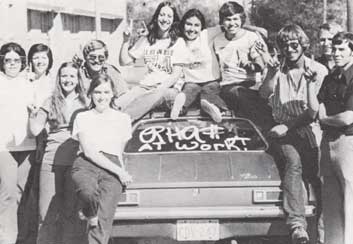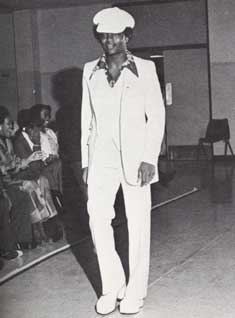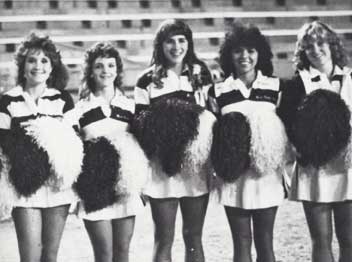by Dr. Peter Petersen, professor emeritus of history
The University Under Watkins, Sherman, Shannon and Roach, 1973-1989
 By the fall of 1973, when Lloyd Watkins became the institution's fourth president, external events were already pushing the University in a different direction. After peaking in 1969 and 1970 at just short of 8,000, enrollment began a steep downward slide. Of the many factors in this turnaround, it is likely that changes in the selective service system and increases in tuition were primary. Because the University's funding was largely enrollment driven, a nearly 20 percent decline in the student body between 1970 and 1972, when combined with the inflationary pressures of the early 1970s, created serious financial problems for the school. The Board of Regents temporarily suspended the granting of tenure and promotions, and many non-tenured faculty were terminated. Adding to the financial woes were substantial deficits in the annual athletic budget. In December 1975 and again in February 1977 the Regents voted to continue membership in NCAA Division I and the Missouri Valley Athletic Conference but only after asking for private support to help lessen the athletic deficit. Frustrated by the school's enrollment and athletic problems, Watkins resigned in May 1977 to accept the presidency of Illinois State University.
By the fall of 1973, when Lloyd Watkins became the institution's fourth president, external events were already pushing the University in a different direction. After peaking in 1969 and 1970 at just short of 8,000, enrollment began a steep downward slide. Of the many factors in this turnaround, it is likely that changes in the selective service system and increases in tuition were primary. Because the University's funding was largely enrollment driven, a nearly 20 percent decline in the student body between 1970 and 1972, when combined with the inflationary pressures of the early 1970s, created serious financial problems for the school. The Board of Regents temporarily suspended the granting of tenure and promotions, and many non-tenured faculty were terminated. Adding to the financial woes were substantial deficits in the annual athletic budget. In December 1975 and again in February 1977 the Regents voted to continue membership in NCAA Division I and the Missouri Valley Athletic Conference but only after asking for private support to help lessen the athletic deficit. Frustrated by the school's enrollment and athletic problems, Watkins resigned in May 1977 to accept the presidency of Illinois State University.
To replace Watkins, the regents selected Max Sherman, a popular political leader who represented the Panhandle in the Texas State Senate. One of Sherman's first actions after assuming the presidency in the fall of 1977 was to announce a streamlining of the administrative structure. The three vice presidencies--academic affairs, financial affairs and student affairs--were eliminated and the offices of Executive Vice President and Business Manager established. Several departments were merged and the School of Business restructured. The administration of the Graduate School was reduced to a half-time position and the Testing, Academic and Career Counseling Center was combined with the Personal Counseling Center to form the Counseling and Testing Center. The General Education Requirements were raised from 35 (in some programs 37) hours to 40 hours with increased emphasis on analytical reasoning, communication skills and cultural heritage.
 During the 1970s there were significant additions to the University's physical resources, including the 2,310 acre Nance Ranch, the Cornette Library, the Agricultural and Natural Sciences Building, Mary Moody Northen Hall, and the Horse Center. Enrollment leveled off at about 6,500 in 1975 and remained relatively stable for the remainder of the decade.
During the 1970s there were significant additions to the University's physical resources, including the 2,310 acre Nance Ranch, the Cornette Library, the Agricultural and Natural Sciences Building, Mary Moody Northen Hall, and the Horse Center. Enrollment leveled off at about 6,500 in 1975 and remained relatively stable for the remainder of the decade.
After a four and a half year tenure as president, Sherman resigned in January 1982 to launch an ultimately unsuccessful campaign for the position of Texas Attorney General. The Board of Regents then gave Gail Shannon, the academic vice president, a one-year appointment as president. A few months later, Shannon received a second one-year appointment.
Eventually, the regents, acting upon the recommendation of a search committee, named Ed D. Roach, dean of the School of Business at Southwest Texas State University, as WTSU's seventh president. Roach assumed office in 1984 and a few months later announced that WT would change its athletic status from NCAA Division I and the Missouri Valley Conference to Division II and the Lone Star Conference. He also called for the preparation of a strategic plan for the University. A University committee began work on the plan in March 1985 and the final document was published some 14 months later. In it Roach called for the University to be reorganized along a four-college model: College of Agriculture, Nursing and Natural Sciences; College of Business and Technology; College of Education and Social Sciences; and College of Fine Arts and Humanities. In addition to reducing the number of colleges from seven to four, the plan called for consolidation of the 27 existing departments into 14 departments or divisions. Other recommendations included the establishment of an Office of Continuing Education and a call that, if possible, savings from a reorganization be devoted to increasing faculty salaries. Although too lengthy and involved to be summarized in this brief history, the strategic plan addressed many other aspects of university life, including athletics and physical facilities.

The last half of the 1980s was a particularly difficult time for WTSU. In addition to the natural concerns that accompanied the strategic reorganization, sagging enrollments and a sharp downturn in the Texas economy created new anxieties among various elements of the University, particularly the faculty. In the fall of 1987, enrollment hit a 22 year low.
A variety of incidents increasingly strained the relationship
between President Roach and the faculty. In 1988 the faculty overwhelmingly voted that it had "no confidence" in the Roach Administration. During the ensuing two years, a $5.5 million renovation of Old Main and the subsequent conversion of the former administration building into a student union, along with a sizable cost overrun for construction of a new presidential home and continued athletic deficits, stretched the University's financial resources to its limits. In October 1990 Roach asked for a nearly half million dollar reduction in the athletic budget. Shortly after the State Auditor released a report highly critical of the University's finances, Roach announced his resignation effective Dec. 31, 1990.
West Texas A&M Presidential Eras
- 1910-1918: The R.B. Cousins Era
- 1918-1948: The J.A. Hill Era
- 1948-1973: The James P. Cornette Era
- 1973-1989: The University Under Watkins, Sherman, Shannon and Roach
- 1989-2005: System Membership and the University Under Thompson and Long
- 2006-2016: The University Under O'Brien
- 2016-Present: The University Under Wendler
